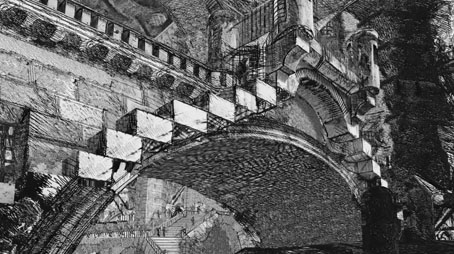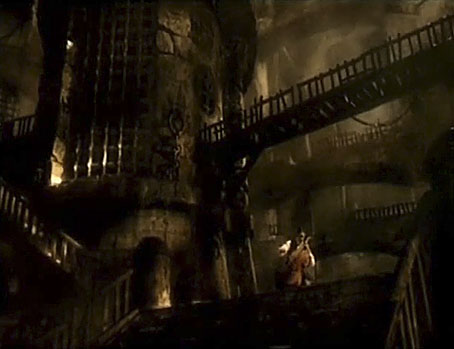Piranesi Carceri d’Invenzione (2010).
When Peacay at BibliOdyssey linked to this short film by Grégoire Dupond I thought it might be one I hadn’t seen before but it turns out I have, and I mentioned the exhibition it was produced for in 2010. No matter, it’s worth drawing attention to again since Monsieur Dupond makes an impressive job of sending a virtual camera through the vast spaces of Piranesi’s Carceri d’invenzione, joining several of the etchings into a series of contiguous chambers.
The Sound of the Carceri (1998).
Dupond’s film uses Bach’s Cello Suite #2 as a musical accompaniment. As noted earlier that choice probably came from Yo-Yo Ma’s Inspired by Bach (1998) in which Bach’s six solo cello suites are performed in different settings. Suite #2 was The Sound of the Carceri directed by François Girard which places the cellist inside a CGI rending of one of Piranesi’s Careri etchings. YouTube has a copy here.
Elsewhere on { feuilleton }
• The etching and engraving archive
Previously on { feuilleton }
• Carceri, thermae and candelabra
• La Tour by Schuiten & Peeters
• Set in Stone
• Piranesi as designer
• Vedute di Roma
• Aldous Huxley on Piranesi’s Prisons



There are many Lego renditions of Escher’s prints – with Relativity as a recurring favourite — but it makes me sad that so far no-one has tackled Piranesi in the Lego medium.
I’m not too worried about that since I’ve grown rather tired of seeing all of popular culture being filtered through the medium of the Lego brick. The reason you get Escher over Piranesi is that those meme things only work when enough people know what’s been converted into Lego. On the level of Escher (never mind any recent film or TV series) Piranesi isn’t at all popular.
Regarding your question about Daniel Crooks I’m more interested in older effects since they have a quality now which has been lost with current CGI. That’s not to say I reject the latter, this post is an example of that.
I don’t know about calling Daniel Crooks’ videos “cgi” — but he’s definitely digital rather than analog.
*Conceptually*, Crooks and Rybczynski are ploughing similar fields. They’re filming events, then lining up all the two-dimensional frames of the film in a three-dimensional block, and creating new frames that slice through the block at oblique angles so that different sections of a frame map onto different times. But *aesthetically* the results are probably different because Crooks has access to HD digital video.
It is probably an indictment of my priorities that I focussed first on the concept rather than the aesthetic.
Still harping back to the Fourth Dimension thread — here’s a a sculptor influenced by Rybczynski.
Piranesi’s Carceri images have always occupied a special seat of honor in my mind from the moment I first saw them years ago, for some of the same reasons that I am so intrigued by this news of Reverbstorm, or why I went through a phase where I insatiably devoured ‘From Hell’ and anything Jack-the-Ripper related. I suppose an adequate contemporary analogy to draw upon would be to take note of how in the French Black Metal scene they have taken the preoccupation with the barbaric wilderness of their Scandanavian predeccessors, but moved it out of the impenetrable and hostile northern forests and into an equally hostile wilderness of decaying and abandoned architectural pandemonium. Barren tree branches choked with ice exchanged for rusted and peeling iron framework. Both caste strikingly similar shadows indeed. In one place the end may come at the hands of an avalanche or a hungry bear, in another by a tattooed drug addict or a rabid stray dog, nothing really better or worse I suppose, all just a matter of taste.
Just as the civilized man, terrified and repulsed by the world outside, builds himself an idealized living tomb that he constantly alters and restructures to satisfy his lofty aims. He does so until the innumberable corroding spouts and pillars and outcropping blooms of masonry begin to cast familiar shadows he has feared since infancy, whose rotting interiors provide hidden lair for the adapted vermin of the new artificial wilderness, and alas, his utopia has come to resemble the hateful world from which he fled.
Misanthropic? Perhaps it is, but I am only illustrating what impression it leaves upon me. If anyone wants to imply that I think John shares such a sentiment just because he likes the pictures as well, or that Piranesi was for illustrating them in the first place, well, I can answer that question better than you can, I am not.
A sidenote regarding the Youtube link, it is amusing to eavesdrop on the quarrels between the rival camps of classical music students.
Wiley: Piranesi’s work is part of the birth of Romanticism, it connects indirectly to the dungeons of Gothic fiction and so on. He was playing his own riff on earlier scenes of prisons which were common in theatrical design but making the theme a more universal one. That’s why they continued to impress people such as De Quincy and Aldous Huxley while the stage designs by the Bibienas are forgotten. Huxley’s lengthy essay (linked on this page) is worth a read for his take on the etchings, the way they connect to 20th-century concerns.